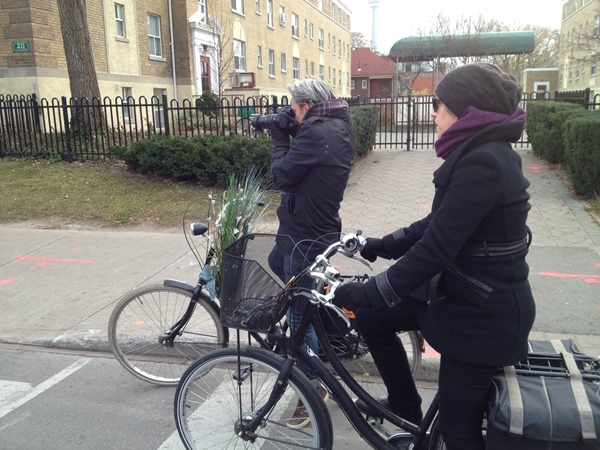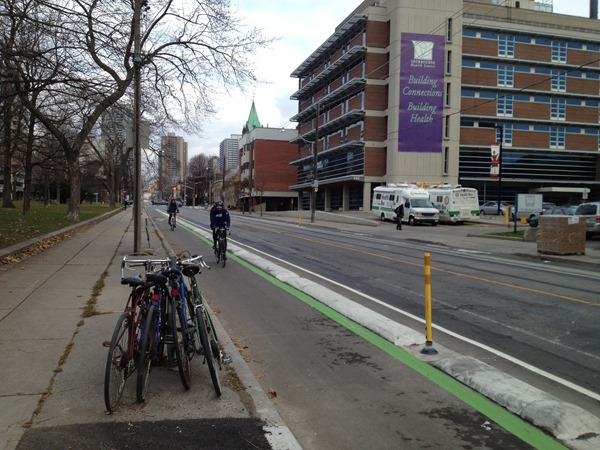
Toronto’s Sherbourne Street Cycle Track – Photo by James Schwartz / The Urban Country
As we rode down Toronto’s first cycle track on Sherbourne Street, Copenhagen’s Bicycle Ambassador and the man behind the “Cycle Chic” trend – Mikael Colville-Andersen asks me,
“Why is everyone talking about the removal of the Jarvis street bike lanes and not talking about this new cycle track?”.
Well, it’s a bit complicated. Yes, the Sherbourne cycle track is a great step in the right direction for the city of Toronto, but the removal of the Jarvis street bike lane set a very unfortunate precedent and leaves hundreds of Torontonians with unsafe conditions.
Colville-Andersen was in the city for one day at the tail end of a Canadian tour of his Kickstand bicycle policy training sessions. Toronto urban cycling consultant Yvonne Bambrick and I showed Mikael around our city, including a ride down Toronto’s first cycle track on Sherbourne street.

Touring Toronto with Mikael Colville-Andersen & Yvonne Bambrick – Photo by James Schwartz / The Urban Country
On nearby Jarvis street, people live, play, work and go to school. Toronto is the only major city in North America that is actively removing bike lanes.
Pedaling the 600 metres out of their way to the parallel Sherbourne street cycle track is not always a viable option. When you live on Jarvis street, you will at some point need to ride along Jarvis street.
The other aspect about Jarvis street is the big lie that it exposes about Toronto politicians. Mayor Rob Ford (who is now pending removal from office for a conflict of interest case) was elected on a platform of cutting costs and eliminating waste at City Hall.
Just one year after installing the Jarvis street bike lane (at a cost of about $80,000), Mayor Ford and other councillors voted to remove the Jarvis lane at an additional cost of $300,000 and re-instate the reversible centre lane, turning Jarvis back into an urban highway.
Further, the main reason cited for removing the Jarvis street bike lane was because it “increased traffic congestion”. However, what the politicians didn’t tell people is that two of the car lanes would be used for car parking 85% of the time.
So one has to wonder how much reverting to the previous street configuration will do to address traffic congestion.
For 85% of an average day, Jarvis street will feature 1 dedicated car lane, two shared car/bike lanes and 2 parking lanes. Prior to spending the $300,000 to revert to this street configuration, Jarvis street contained 4 dedicated car lanes, 2 dedicated bike lanes, and no parking lanes.
During rush hours, Jarvis street will now feature 3 dedicated car lanes, and 2 shared car/bike lanes and no parking lanes. The shared car/bike lanes put bicyclists at risk, and although I’m sure many bicyclists will find other streets to use as an alternative, some won’t have that luxury.

Jarvis street after street scrubbing to remove bike lanes – Photo by James Schwartz / The Urban Country
Over on Sherbourne street, you can almost smell the fresh green paint that lines the brand new cycle track.
In my opinion, the Sherbourne street cycle track was fairly well done. The track features curb separation at times, but in certain spots there is no curb, making it potentially susceptible to temporary car parking.
Whether cars decide to use the cycle track for temporary parking will depend on how many bicyclists are using the track, as well as how well car parking is enforced.
For most of its length, the cycle track is wide enough for two bicyclists to ride side-by-side, making it convenient for a bicyclist to pass another – an important feature for a cycle track with curbs.

Toronto’s Sherbourne Street Cycle Track – Photo by James Schwartz / The Urban Country

Toronto’s Sherbourne Street Cycle Track – Photo by James Schwartz / The Urban Country
The one aspect of the cycle track that didn’t impress me is that it doesn’t continue south to connect the waterfront route. The track ends at King street in the south.
North of King street, construction crews continue to build the cycle track on the east side of Sherbourne street.

Construction of the Sherbourne cycle track on the east side of Sherbourne street – Photo by James Schwartz / The Urban Country
The citizens of Toronto did gain a fairly decent cycle track on Sherbourne street, but at the cost of the safety of the bicyclists who still need to use Jarvis street.
The number of bicyclists on Jarvis street went from about 300 per day to about 900 per day, a significant increase. Safety for all road users on Jarvis street also improved after the bike lanes were implemented.
Now we have wasted $300,000 to reconfigure the road, decreasing safety for everyone and bringing us back to the 1970’s.
History shows that traffic congestion is not mitigated by turning downtown streets into urban highways. Creating more road space downtown brings more cars downtown, increasing traffic congestion on all of our downtown streets.
Jarvis street was never a great street for riding a bicycle, but the bike lane made it more comfortable, and the removal of the bike lane will only put more bicycle back on the sidewalks of Jarvis street.
James D. Schwartz is a Transportation Pragmatist and the Editor of The Urban Country. You can contact James at james.schwartz@theurbancountry.com or follow him on Twitter.
Related Articles:
- Bicycle Infrastructure Continuity (Aug 2012)
- Streetcar Tracks & Bicycles (Aug 2012)
- Complete Streets in Amsterdam (Oct 2011)
- 10 Observations About Bicycling in Amsterdam (March 2012)
- Trashy Bike Lane (Nov 2011)
- Bicycle Transportation Should Be Taken Seriously (March 2012)



I haven’t tried the Sherbourne cycle tracks yet, but from your pictures they look rather nicely done. Too bad about the lack of continuity at King Street, though.
I haven’t tried the Sherbourne cycle tracks yet, but from your pictures they look rather nicely done. Too bad about the lack of continuity at King Street, though.
I was wondering if there were any plans for winter? Will the cycle track be cleared of snow, how will the curb impact snow removal or will the track get the snow plowed off of the main road?
The city has said the cycle track will be cleared of snow similar “to that of the rest of the roadway”: http://www.toronto.ca/cycling/network/downtownupgrades/faq.htm#a01
But we will see how it turns out in reality. I will keep a close eye on it.
I was wondering if there were any plans for winter? Will the cycle track be cleared of snow, how will the curb impact snow removal or will the track get the snow plowed off of the main road?
why has the brand new sidewalk already been cut and tarred in that bus photo??
I think that’s supposed to be a marker for where the bus passengers are supposed to stand while waiting for the bus. Maybe they have yet to paint it?
why has the brand new sidewalk already been cut and tarred in that bus photo??
Sherbourne cycle track is great however, People think that bike lanes are Green P! Today one my way to work there were 3 cars parked on the bike lane in 3 differente spots.
I think that’s supposed to be a marker for where the bus passengers are supposed to stand while waiting for the bus. Maybe they have yet to paint it?
The city has said the cycle track will be cleared of snow similar “to that of the rest of the roadway”: http://www.toronto.ca/cycling/network/downtownupgrades/faq.htm#a01
But we will see how it turns out in reality. I will keep a close eye on it.
The plan is to build the cycle tracks to the lake but there is condo construction and Queens Quay construction holding it up until next year.
In 2014 we will get another cycle track on Wellesley and hopefully Harbord.
The plan is to build the cycle tracks to the lake but there is condo construction and Queens Quay construction holding it up until next year.
In 2014 we will get another cycle track on Wellesley and hopefully Harbord.
I’m still not going to use it much … riding down Sherbourne at 4 a.m. (when I cycle to work) is not my idea of safe cycling LOL
I’m still not going to use it much … riding down Sherbourne at 4 a.m. (when I cycle to work) is not my idea of safe cycling LOL